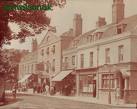James Johnstone 1862 - 1953
October 15, 2008
 James Johnstone MRCS
1890
FRCS
Eng.
MB
1862 - 1953 Fellow of The Royal College of
Surgeons,
was
President
of the British Homeopathic
Society,
President
of the British Homeopathic Congress, Surgeon and Physician for the
Diseases of
Women
and Consultant in Midwifery at the London Homeopathic
Hospital.
James Johnstone MRCS
1890
FRCS
Eng.
MB
1862 - 1953 Fellow of The Royal College of
Surgeons,
was
President
of the British Homeopathic
Society,
President
of the British Homeopathic Congress, Surgeon and Physician for the
Diseases of
Women
and Consultant in Midwifery at the London Homeopathic
Hospital.
James Johnstone also practiced at 47 Sheen Road, Richmond, Surrey.
James Johnstone was a contemporary of William Bayes, Charles Harrison Blackley, John Galley Blackley, David Dyce Brown, George Henry Burford, James Compton Burnett, John Moorhead Byres Moir, John Henry Clarke, H A Clifton Harris, Robert Thomas Cooper, R M Le Hunt Cooper, Paul Francois Curie, Abraham Dixon, Robert Ellis Dudgeon, John Epps, Washington Epps, Giles Forward Goldsborough, Clarence Granville Hey, Ethelbert Petrie Hoyle, Richard Hughes, C T Knox Shaw, Thomas Robinson Leadam, Octavia Margaret Sophia Lewin, Edward M Madden, Henry R Madden, David MacNish, Edwin Awdas Neatby, Alfred Crosby Pope, Mathias Roth, Harold Wynne Thomas, Charles Edwin Wheeler, John Weir, Percy Roberts Wilde, David Wilson, James Craven Wood, Dudley d’Auvergne Wright, Stephen Yeldham and many others.
James Johnstone was involved in the setting up of The Homeopathic Hospital at Neuilly in France in 1914-1916:
At a meeting of the Acting Committee of the International Homeopathic Council held in London late in 1914, its deliberations included a proposition for the establishment of a Homeopathic Hospital, under military control, for medical cases, on the Western front of the Allies.
The President of the British Homeopathic Society (Harold Wynne Thomas), the President of the previous British Homeopathic Congress (Dr. James Johnstone), together with the Vice President of the International Homeopathic Council George Henry Burford, met by arrangement the Chairman of the London Homeopathic Hospital, Robert Henryson Caird, Esq., J.P., to consider the necessary preliminaries.
Their consultation issued in the nomination of a Provisional Committee constituted by representatives of the principal homeopathic activities in Great Britain, and the publication of a statement of the case, with an appeal for funds to those favourably inclined to the work.
Thus did the leaders of British Homeopathy lead, and the response of the English speaking homeopaths the world over was immediate and maintained. Fortified by this support, the Provisional Committee nominated two Commissioners (Dr. Hoyle and David MacNish) to proceed to France to confer with the military authorities there, as well as with the principal homeopathic physicians in Paris.
As the issue of this investigation, the Committee decided to work under the auspices of the French Red Cross Society, and to internationalism as far as possible, the interest it was desirable to arouse of homeopathic supporters in this special procedure.
Towards the end of the nineteenth century some, on returning on furlough to England, asked for instruction in first aid. In response, doctors at the London Homeopathic Hospital invited individual missionaries to attend their outpatient clinics.
The British Homeopathic Association (BHA) had just been formed and their Education Committee undertook to organise lectures in basic medicine and surgery. A missionary sub committee was formed under the Chairmanship of George Henry Burford, Physician for the Diseases of Women at the London Homeopathic Hospital.
The initial programme involved Dr James Johnstone, Lecturer in Midwifery with the assistance of the medical staff of the hospital. Edwin Awdas Neatby, Lecturer and Clinical Physician for Diseases of Women, was appointed Honorary Secretary and later (in 1927) became Dean.
The newly formed school opened at the London Homeopathic Hospital in autumn 1903, with 24 students enrolled. It moved to 2 Powis Place in the mid 1920s when the hospital room used by the students was needed as a study room for nurses training for State Registration, which had just been introduced.
This freehold property was owned by the hospital and is situated in a cul de sac off Great Ormond Street, separating the Children’s Hospital from the London Homeopathic Hospital. The MSM rented the property and occupied all three floors using it as a base for administration and the Dean’s office. A study and lecture room was created and the top floor was used to develop a museum and library. It remained the home of MSM, although it occupied less of the space as student numbers decreased, until its closure in 1996.
Virginia Woolf ’s servants Nellie Boxall and Lottie Hope were patients of James Johnstone, surgeon at the London Homeopathic Hospital, and Virginia Woolf wrote to Lotte when she was at the London Homeopathic Hospital.
James Johnstone wrote Diagnosis by Microscopic Examination as an aid to successful treatment, The Evolution of Homeopathy, and many journal articles, including articles for The British Homeopathic Review, The Journal of the British Homeopathic Society, The Hahnemannian Monthly, and for The Journal of Surgery, Gynecology and Obstetrics in 1905, which included many articles on homeopathy.
Of interest:
Thomas H Johnstone was on the Committee of the English Homeopathic Association in 1849, and on the Management Board of the Hahnemann Hospital at 39 Bloomsbury Square in 1852.